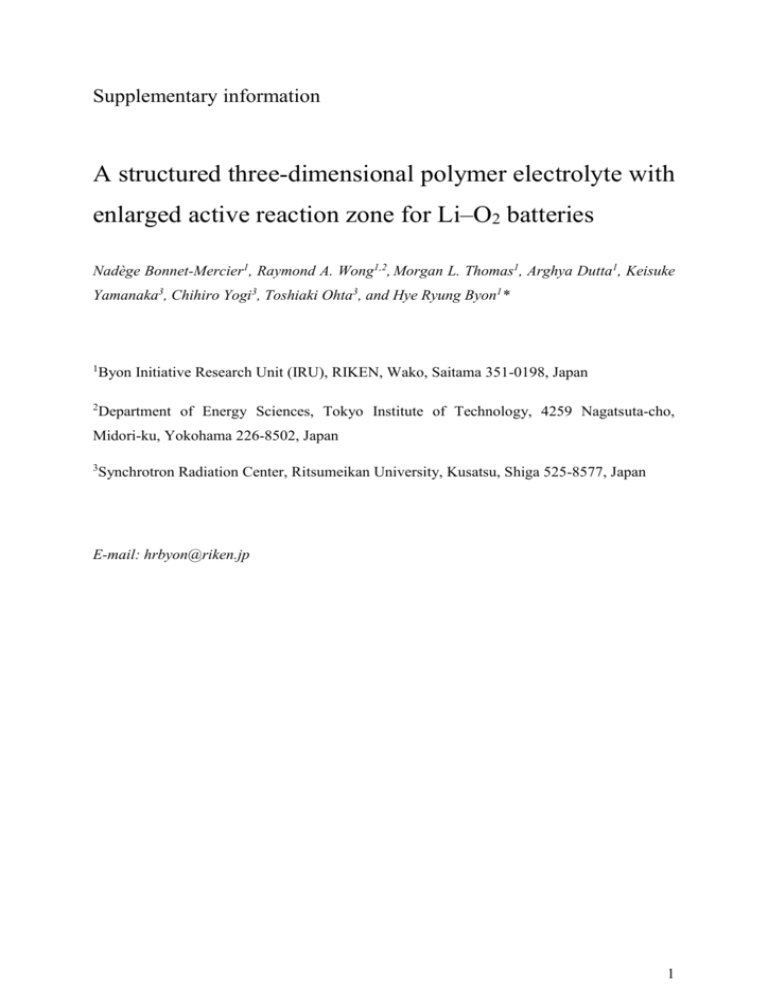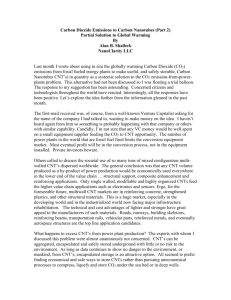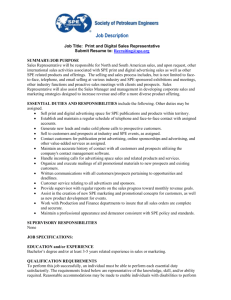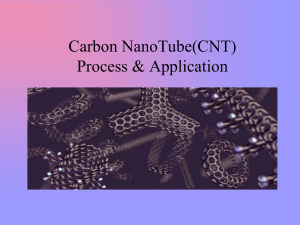Template for Electronic Submission to ACS Journals
advertisement

Supplementary information A structured three-dimensional polymer electrolyte with enlarged active reaction zone for Li–O2 batteries Nadège Bonnet-Mercier1, Raymond A. Wong1,2, Morgan L. Thomas1, Arghya Dutta1, Keisuke Yamanaka3, Chihiro Yogi3, Toshiaki Ohta3, and Hye Ryung Byon1* 1 Byon Initiative Research Unit (IRU), RIKEN, Wako, Saitama 351-0198, Japan 2 Department of Energy Sciences, Tokyo Institute of Technology, 4259 Nagatsuta-cho, Midori-ku, Yokohama 226-8502, Japan 3 Synchrotron Radiation Center, Ritsumeikan University, Kusatsu, Shiga 525-8577, Japan E-mail: hrbyon@riken.jp 1 Figure S1. Top-view (a–b) SEM and (c) AFM topography (left) and phase (right) images of P(EO)20LiTFSI. The scale bars in (c) are 1 μm. The color bar on the right of AFM topography image indicates the z-axis scale. For SEM images, the P(EO)20LiTFSI film was coated with a thin layer of gold via sputtering. The AFM images of P(EO)20LiTFSI film, in the absence of gold-sputtering preparation, show domains with hundreds of nanometers. 2 Figure S2. P(EO)20LiTFSI characterization. (a) Differential scanning calorimetry (DCS) of P(EO)20LiTFSI (top solid line) and PEO-only (bottom dashed line) films. The melting temperature of P(EO)20LiTFSI (~55 oC) is significantly lower than the PEO-only membrane (~67 oC), indicating the contribution of Li salt for the phase transition of PEO. The inset shows a glass transition (Tg) peak of the P(EO)20LiTFSI in a magnified region of –30 ~ –50 o C. DCS was performed on a Q20 calorimeter from TA Instruments and temperature was elevated from –80 to 150°C at a ramping rate of 10 °C min–1 under N2 atmosphere. (b) Arrhenius plot of P(EO)20LiTFSI measured by electrochemical impedance spectroscopy (EIS) using a stainless steel (SS) symmetric cell (SS/P(EO)20LiTFSI/SS). The orange dot denotes an ionic conductivity of ~3.2 10–4 S cm–1 at 55 oC. The EIS (Biologic coupled with EC-Lab software) measurements were carried out at 0.1 Hz to 1 MHz with an applied voltage of 10 mV at a temperature range of 25–80°C. (c) Electrochemical impedance response with respect to temperature using Li symmetric cell (Li/P(EO)20LiTFSI/Li). The interfacial resistances between the P(EO)20LiTFSI and metallic Li are ~2302, 140, and 92 with increasing temperature of 25, 55, and 60 °C, respectively. The interfacial resistance is contributed to the sum of resistances of charge transfer and passivation film on the metallic Li. The EIS measurements were carried out at 0.01 Hz to 1 MHz at a temperature range of 25–60°C. 3 Figure S3. Low-magnification SEM images of (a–b) CNT and (c–d) CNT/SPE surfaces. Scale bars are (a, c) 50 μm and (b, d) 3 μm. The 3-D CNT network structures are retained for the CNT/SPE. 4 Figure S4. Top-view AFM images of CNT/SPE with (a) topography and (b) phase modes. The scale bars are 150 nm. The color bar on the right of topography image indicates the zaxis scale. 5 Figure S5. AFM topography images of CNT-only film surface. The color bar on the right of AFM topography image indicates the z-axis scale. 6 Figure S6. The 1st-cycled discharge-recharge profiles of Li–O2 cells under O2 (blue) and Ar (black) atmosphere at a current rate of 0.05 mA cm–2 and a temperature of 55 oC. 7 Figure S7. The 1st-cycled discharge-recharge profiles of Li–O2 cells at a current rate of 0.05 mA cm–2 with CNT/SPE P(EO)20LiTFSI (solid curve) and CNT/tetraglyme electrolyte containing 0.5 M LiTFSI (dashed curve). The working temperature is 55 oC for CNT/SPE and 25 oC for CNT/tetraglyme cells. 8 Figure S8. XANES spectra of Li, O and C–K edges with the fluorescence yield (FY) mode for as prepared (black) 1DC (red) and 1RC CNT/SPE (blue), acquired at a current rate of 0.05 mA cm–2. The gray spectra are standard powders of lithium compounds. The nDC and nRC denote n-times cycled electrodes at the end of discharge and recharge, respectively. 9 Figure S9. Thin film XRD patterns of 1DC CNT/SPE acquired at a discharge current rate of 0.01 (purple) and 0.05 mA cm–2 (red) with reference to as-prepared CNT/SPE (black) and powders of LiOH (gray), and Li2O2 (gray). The newly formed pattern after 1DC at the lower current rate of 0.01 mA cm–2 exhibits the dominant LiOH reflections (101 at 2 theta of 32.35o, which is slightly shifted compared with the reference LiOH) and minor Li2O2 (e.g. very small reflection of 101 at 34.85o) at the end of 1DC. These products are not clearly observed when the 1DC is carried out at the higher discharge current rate of 0.05 mA cm–2. Thin film XRD was performed using a Rigaku Smartlab with a Cu Kα source (λCu,Kα1 ≈ 1.542 Å) at a scan rate of 0.5 degree min–1. 10 Figure S10. 1H NMR spectra of 1DC (red), 1RC (blue), and 2DC (green) CNT/SPE, acquired at a current rate of 0.05 mA cm–2, with reference to as-prepared CNT/SPE (black). 1 H chemical shift (δ) intensity of formate (HCO2D) at 8.46 ppm, referred to 0.05 wt% TMSP in D2O, increases from 1DC to 2DC while that of acetate (CH3CO2D) at 1.92 ppm is very small for all samples. The samples were prepared by immersing of the electrodes in a D2O (Aldrich) mixed with 0.05 wt% 3-(trimethylsilyl)propionic-2,2,3,3-d4 acid, sodium salt (TMSP, Aldrich) for 2 days in the glove box. A total 600 μL of D2O/TMSP was collected for the NMR measurement. 1H NMR spectroscopy analysis was performed using a 500 MHz Varian NMR system. 11 Figure S11. XRD and XANES spectra of 1DC CNT/SPE with dried SiO2 nanofiller at 300 o C acquired at a discharge current rate of 0.01 mA cm–2. (a) Thin film XRD pattern with as- prepared SPE, LiOH, and Li2O2. The reflections of the as-prepared SPE are occasionally well pronounced as shown here. (b) XANES spectra of O K edge with the FY (left) and TEY (right) mode with LiOH, Li2CO3 and Li2O2. All data corroborate the primary 1DC product of LiOH. 12 Figure S12. 1H NMR spectra of as-prepared, 1DC, 1RC, and 2DC CNT/SPE acquired at a low current rate of 0.01 mA cm–2. Unlike Figure S11, a significant peak of methyl ether (OCH3) at a 1H chemical shift (δ) of ~3.4 ppm appears for 1DC and 2DC CNT/SPE. The formate peak is also notable for 1RC and 2DC. Peaks at 1H chemical shift (δ) of ~1.3, ~3.0 and ~4.0 ppm could not be assigned at this time. 13 R 1 O O R R 2 . RH R 1 . O R2 O O2 R . 1 O O RH .O R R 2 O ½O2 peroxide R 1 hydroperoxide HO (a) formaldehyde H2C=O ½O2 + HCO2H formic acid R 2 O O R H O O . O (b) 1 alcohol R OH + O 1 O R O R 2 (c) 1 R O + R OH alcohol O 2 1 O ethanoate ester R O H methanoate ester + 2 OH alcohol 2 hemiacetal oxyl radical (d) H O R R 2 . O R . 1 O . RH R . R + R RH O 2 O R H 1 O methyl ether H2O + HCO2H Figure S13. Proposed mechanism of dissociation of PEO matrix in Li–O2 cell: oxidative decomposition of PEO via a peroxide intermediate. This diagram shows a sub-set of possible reaction pathways based on reports on the thermal oxidative decomposition of PEO, namely (a) six-membered ring intramolecular rearrangement1-3, (b) “β scission” 4,5 , (c) C-O scission3 and (d) C-C scission3. Extrapolating this reaction scheme to the Li–O2 battery, the peroxide is a key intermediate. The radical initiator, R, is assumed in this case to be the superoxide radical6, or any other nucleophilic species formed during the decomposition. Further oxidation of the depicted species then leads to increasing quantities of water and formic acid, resulting in lithium hydroxide and lithium formate1. The presence of a methyl ether in the NMR spectrum (Figure S12) after discharge can be attributed to reaction route (d) via the hemiacetal oxyl radical. Moreover, the presence of formic acid in the first recharge and second discharge can be attributed to reaction route (a) via the hydroperoxide. 14 Figure S14. Linear sweep voltammetry (LSV) of CNT/SPE and CNT in 0.5 M LiTFSI in tetraglyme at a sweep rate of 1 mV s–1 under Ar atmosphere. The working temperature is 55 o C for CNT/SPE and 25 oC for CNT/tetraglyme cells. In the CNT/SPE cell, the CNT/SPE was sandwiched between metallic Li disc and SS current collector. The CNT/tetraglyme cell was comprised of metallic Li, Celgard and glass fiber separators, CNT electrode and SS current collector. 15 Figure S15. In situ OEMS result of 1st (dashed lines) and 2nd (solid lines) recharge of Li–O2 cell with CNT/tetraglyme (0.5 M LiTFSI in tetraglyme) at a current rate of 0.2 mA cm–2 and 25 oC. 16 Figure S16. High-magnification AFM images of as-prepared (left column), 1DC (middle column) and 1RC (right column) CNT/SPE surfaces with topography (top row) and phase (bottom row) modes. The color bars on the right of topography images indicate the z-axis scale. The scale bars are 200 nm. 17 Figure S17. Top-view SEM images of (a) as-prepared, (b) 1DC, and (c) 1RC CNT/SPE. The scale bars are 1 μm. 18 Figure S18. The 2nd (dashed curves) and 3rd (dot curves) cycled discharge-recharge profiles of CNT/SPE Li–O2 cell at a current density of 0.05 mA cm–2 and 55 °C. The inset shows an optical image of disassembled CNT/SPE after the cell failure. 19 References 1 Decker, C. & Marchal, J. Caractérisation de réactions primaires de dégradation oxydante au cours de l'autoxydation des polyoxyéthylènes à 25°C: Étude en solution aqueuse avec amorçage par radiolyse du solvant. VI. Polyoxyéthylène: Produits d'oxydation et schéma cinétique. Die Makromolekulare Chemie 166, 155-178 (1973). 2 Yang, L., Heatley, F., Blease, T. G. & Thompson, R. I. G. A study of the mechanism of the oxidative thermal degradation of poly(ethylene oxide) and poly(propylene oxide) using H-1- and C-13-NMR. Eur Polym J 32, 535-547 (1996). 3 Gallet, G., Carroccio, S., Rizzarelli, P. & Karlsson, S. Thermal degradation of poly(ethylene oxide-propylene oxide-ethylene oxide) triblock copolymer: comparative study by SEC/NMR, SEC/MALDI-TOF-MS and SPME/GC-MS. Polymer 43, 1081-1094 (2002). 4 Dulog, V. L. & Storck, G. Die oxydation von polyepoxiden mit molekularem sauerstoff. Die Makromolekulare Chemie 91, 50-73 (1966). 5 Mkhatresh, O. A. & Heatley, F. A study of the products and mechanism of the thermal oxidative degradation of poly(ethylene oxide) using H-1 and C-13 1-D and 2D NMR. Polym Int 53, 1336-1342 (2004). 6 Freunberger, S. A. et al. The lithium–oxygen battery with ether-based electrolytes. Angew. Chem. Int. Ed. 50, 8609–8613 (2011). 20






